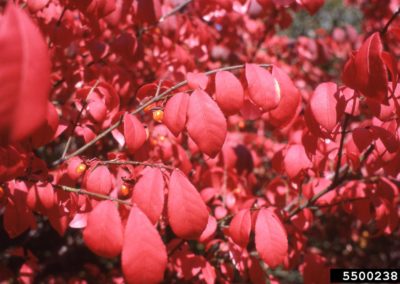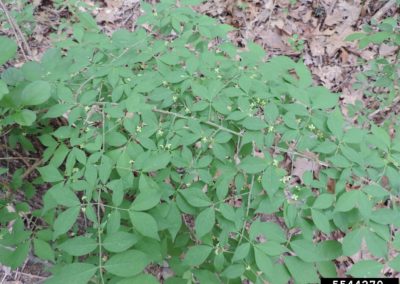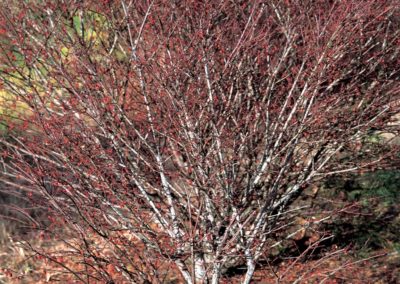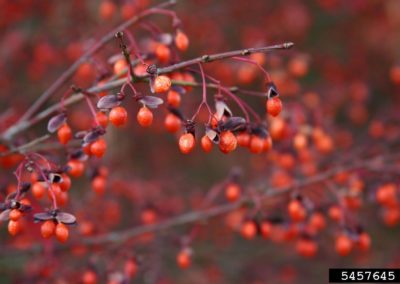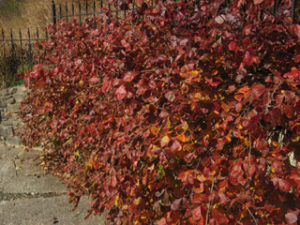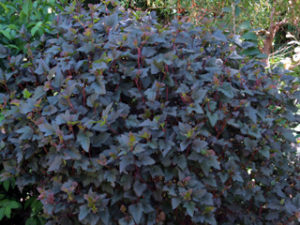Burning Bush (Euonymus alatus)
Invasive Management Profile
Burning Bush is widely used as a hedge plant but has started to invade our Indiana forests. Although Burning Bush is known for its leaves turning bright red in the fall, don’t confuse it with other native red bushes such as the Eastern Wahoo and Strawberry Bush. Because Burning Bush is a beautiful color-changing bush, it is still sold in some stores in Indiana, so please make sure to read all labels to ensure you are not buying this harmful and invasive plant.
Identification
Burning Bush is a deciduous shrub, and if left unpruned, the compact bush will grow to about 12 feet tall and 15 feet wide, and the species (winged) form will grow to about 15 feet tall and 20 feet wide. The leaves are opposite, which means they appear at the same position on the stem on each side, dark green leaves are less than a 2 inches long, with finely serrated edges and taper at the tips. Two to four corky ridges often form along the length of young stems, though they may not appear in shaded areas or closed canopies. Burning Bush blooms from April to June with small yellowish green flowers. Burning Bush does have small purple/red fruits, although these are hard to find among the bright red leaves in the fall. The fruit matures from September to October, then splits to reveal an orange seed.
Tools & Supplies Needed
- Shovel and/or spade
- Handsaw and/or lopper
- Protective eyewear, gloves, and clothing
- Paper or plastic bags for disposal
Removal Methods
Pull small seedlings or any shrubs that can easily be removed by hand. If you decide to remove a smaller infestation completely, without using herbicide, make sure to use a spade, weed wrench, or sharp shovel to remove the main root system.
STEP 1 : Identify plant using our identification tips and photos as well as the time of year and growth stage.
STEP 2 : Wear protective eyewear, gloves, and clothing.
STEP 3 : Use your hand to grab the bottom of the plant, twist, and pull.
STEP 4 : When pulling, make sure to remove the taproot, which is the main root system (this may be easily removed with a spade or shovel as well).
STEP 5 : Make sure to place all plant debris into a plastic or paper bag to control seed spread.
For larger Burning Bush plants, cutting the bush with a saw or axe near the ground will be necessary. When doing this, you may want to use an herbicide treatment to kill the plant. Treat the plant early in the summer before the seed splits. When using herbicide always read the label and wear protective eyewear, gloves, and clothing. Always use herbicide on a dry and windless day to prevent killing native species. Use a strong formulation of herbicide (~40-50% solution of either glyphosate or triclopyr), and spray or paint the stump with a paintbrush or herbicide sponge. Herbicide should be applied within 30 minutes of the cut.
STEP 1 : Identify plant using our identification tips and photos as well as the time of year and growth stage.
STEP 2 : Wear protective eyewear, gloves and clothing.
STEP 3 : Cut the bush 5 inches from the ground.
STEP 4 : Once cut, apply undiluted herbicide to the stump. Or, if possible, dig up the root system using a sharp shovel. If you choose to use herbicide click here for more safety information.
STEP 5 : For removal of the root system, start digging 3 feet away from the base of the stump.
STEP 6 : Once you can see the majority of the rootball, slide your shovel under it and gently begin loosening and prying it up, away from the ground.
STEP 7 : Once the rootball is free place it and all clippings on a tarp to stop the spreading of seeds or regrowth.
Disposal
Burning Bush can be used as mulch or composted as long as the plant is completely dead when doing so. Place the removed plant on a tarp to dry in the sun. Make sure to bag all seeds and flowers to prevent seed dispersal. Small sapling shrubs can be disposed of in the trash and will be picked up through regular trash collection. Large Burning Bush shrubs can be picked up through heavy trash collection provided they are tied into bundles no larger than 3 feet by 3 feet. Heavy trash collection guidelines and monthly pick-up days for your address can be found here.
Beyond trash collection services, you may need to either hire someone to come and remove the yard waste generated from your Burning Bush removal or haul the waste away yourself. Many landscaping companies will accept yard waste for a small cost. They then process this material into mulch or compost. Click here to learn more about tree removal services in your area.
Native Alternative Species
To learn more about natives and how to landscape with them click here.
Fragrant sumac (Rhus aromatica)
|
Growth Type: Deciduous shrub
Height: 2 to 6 feet
Spread: 6 to 10 feet
Bloom Time & Description: April; showy yellow flower
Fruit: Showy
Light exposure: Full sun to part shade
Attracts: Birds, Butterflies
Tolerate: Rabbit, Drought, Erosion, Clay Soil, Dry Soil, Shallow-Rocky Soil, Black Walnut
Find more information here.
|
Photo Courtesy of INPAWS |
Ninebark (Physocarpus opulifolius)
|
Growth Type: Deciduous shrub
Height: 5 to 8 feet
Spread: 4 to 6 feet
Bloom Time & Description: May to June; showy white or pink flower
Fruit: Showy
Light exposure: Full sun to part shade
Attracts: Birds, Butterflies
Tolerate: Drought, Erosion, Clay Soil, Dry Soil, Wet Soil, Shallow-Rocky Soil, Black Walnut
Find more information here.
|
Photo Courtesy of INPAWS |

